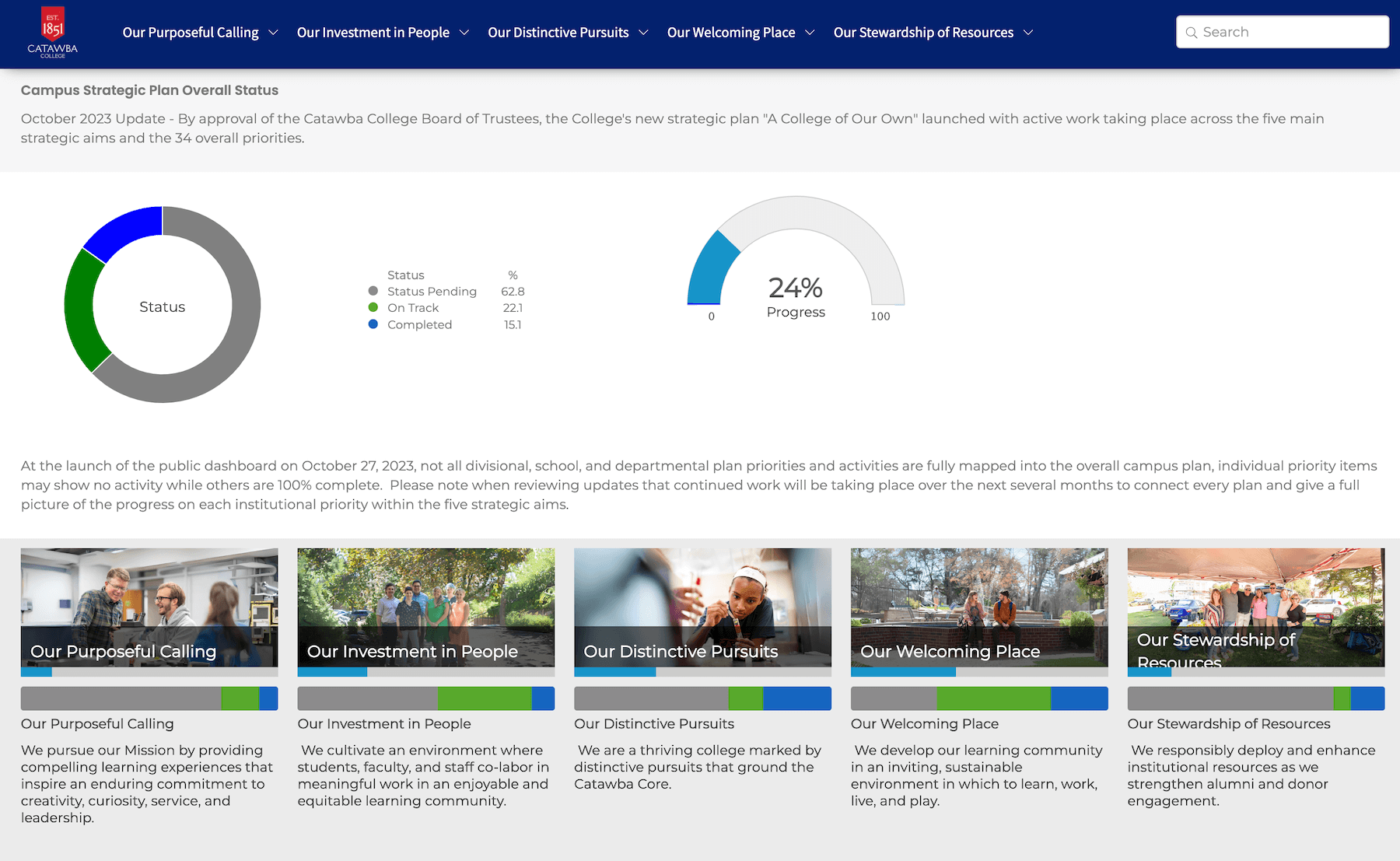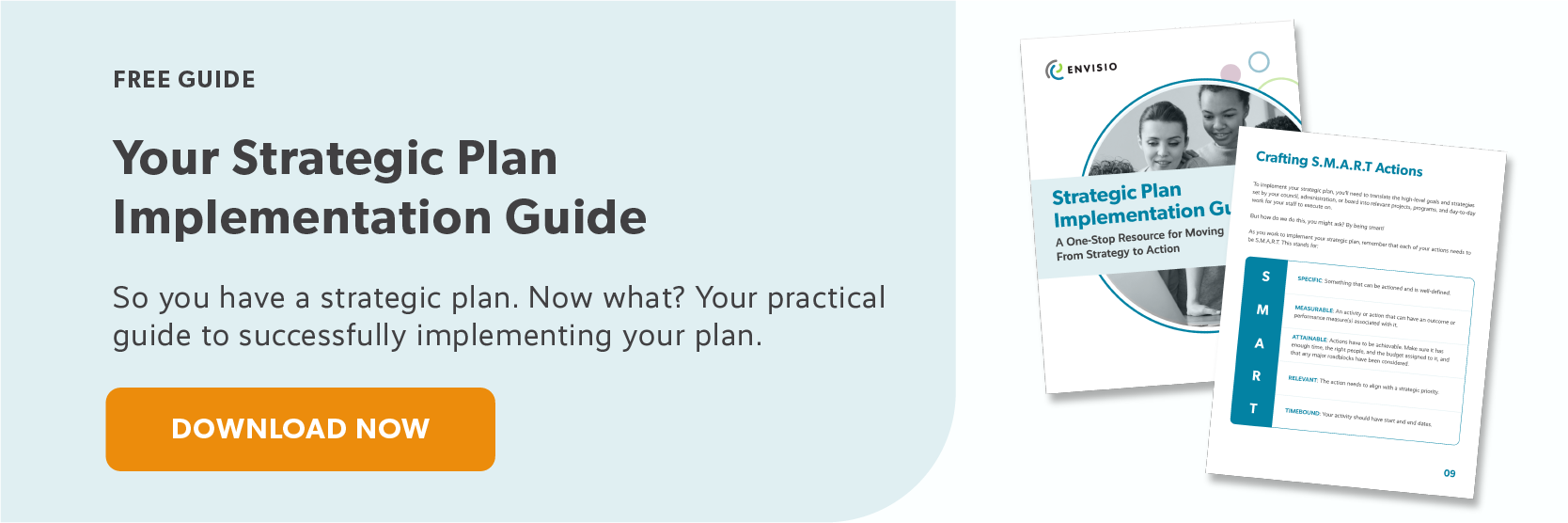Contents
Welcome back to our Public Sector Performance Outcomes series!
Each quarter, we showcase the outstanding strategic accomplishments of our customers, shedding light on their success in accomplishing pivotal actions, meeting performance-based management and measurement outcomes, and implementing key strategic initiatives.
Our enthusiasm for celebrating these victories stems from our appreciation for tangible outcomes and strategic resource allocation in the public sector.
So without further ado, let us take a moment to applaud four remarkable achievements! We will be looking at data-rich dashboards, meticulous performance measurement and KPIs, improved metrics, resilience-building for climate change, and efforts to better support communities getting in touch with nature.
Public dashboard launch with super planners, Catawba College, NC
Catawba College launched their public dashboard in October of 2023, displaying their new 2023 – 2029 Strategic Plan. This is an exciting achievement. Catawba has been involved in an extremely thorough, data-rich strategic planning process that laid careful groundwork for measurable KPIs and goals—all to ensure their plan can be operationalized. They are doing everything right: from breaking down complex goals into actionable items, to having specific, measurable indicators of success. (It’s no secret that we are big fans of SMART goals and action plans!)
Catawba College’s strategic plan is broken into five distinctive strategic pillars:
- Our Purposeful Calling – This pillar focuses on actions that are aimed towards creating learning experiences that reflect and deepen creativity, curiosity, service, and leadership.
- Investing in our People – The actions in this pillar involve ensuring an equitable and enjoyable learning and working environment.
- Our Distinctive Pursuits – These are actions aimed towards helping them retain their distinctive and unique characteristics that have made Catawba one of the top liberal arts colleges in the Southern US.
- Our Welcoming Place – This pillar is aimed at modernizing the campus, as well as establishing (and deepening) community ties.
- Our Stewardship of Resources – This is aimed at financial sustainability, data-driven decision making, and donor and alumni engagement.
Catawba’s focus is all about balance; their strategic pillars and actions include higher-level goals, such as creating a culture of well-being and equity, and specific goals, such as receiving a “Great Colleges to Work For” designation.
Congratulations to Catawba for launching their public dashboard—this is a major milestone in their strategic plan, and a benchmark for strategic plans in liberal arts colleges!
Place-based justice and flood resilience in the City of Philadelphia, PA
Place-based justice is a term that refers to the geographical and spatial components to justice and fairness in society. To put it simply, community-building with a place-based justice lens puts context, history, and most importantly, the land and the people who do (or do not) have access to it, at the heart of those approaches and conversations. Living in a historically red-lined or segregated area, or being subject to ongoing land dispossession or resource extraction, are all examples of place-based justice concerns.
In Philadelphia, The Office of Sustainability operationalized their portion of the Operational Transformation Fund to formulate and execute a place-centered framework to address long standing environmental justice issues in the Eastwick neighborhood. Eastwick, a historically segregated and low-income area, is also prone to serious flooding. Responding to Eastwick’s environmental problems, then, requires an approach to sustainability that reckons with the reality of this neighborhood’s history.
New Orleans Public Library, LA, are data superstars
We previously shone a light on New Orleans Public Library (NOPL), and their strategic plan. For a city as rich in history, diversity, and vitality as New Orleans, having a community center that supports that vibrancy is a must.
And when it comes to public sector performance outcomes, data is key.
If you take a glance at New Orleans Public Library’s data snapshot (which they update quarterly), you’ll be impressed by their commitment to data collection and the breadth of what they track. We want to celebrate the fact that in Q4 2023 (October to December) the New Orleans Public Library had the most visits logged since before the pandemic. While the numbers are not back up to what they were before COVID-19, they are steadily climbing.
Capital improvement for park systems in the City of Bloomington, MN
The Park System Master Plan (PSMP) of the City of Bloomington, MN, is aimed at sprucing up (pardon the pun) their parks and making sure they’re the coolest hangout spots for everyone in the community—both now and for generations to come. The master plan incorporates local and national park recreation trends as well as feedback from extensive community engagements, plus some serious TLC for maintenance and long-term park sustainability.
The PSMP emerged through this process as a thoughtful blueprint—crafting a discerning 20-year vision for Bloomington’s parks, trails, recreation, and open space systems. In their expansive canvas of over 9,000 acres, with nearly 3,000 acres under city ownership, 36% of Bloomington’s 38 square miles are dedicated to parkland or open space. Their focus for this space is to update amenities, develop a prioritization strategy to guide decision-making and investments, and ensure the park systems remain equitable and accessible to all.
Over the last three months, the City of Bloomington PSMP achieved several significant milestones, including utilization of an Equity Prioritization tool for the 2024-2033 Capital Improvement Plan (CIP) by November 2023. Additionally, an annual programming survey was successfully implemented to pinpoint barriers to participation and identify unmet program needs. This is one of our favorite ambitious and necessary public sector performance outcomes!
—
That wraps up our public sector performance outcomes series for 2023!
We love a success tale. By digging into these outcomes, we can better uncover the secrets of what clicked and what could use a little extra tinkering in future projects. We’ll see you again in April, for our Spring celebration of public sector accomplishments!
Get the guide ↓
These plans succeed because they are implemented with specific and measurable actions towards long-term goals. If you would like some help on going from planning to action, and getting a performance measurement program in place, we invite you to check out our Strategic Plan Implementation Guide.








